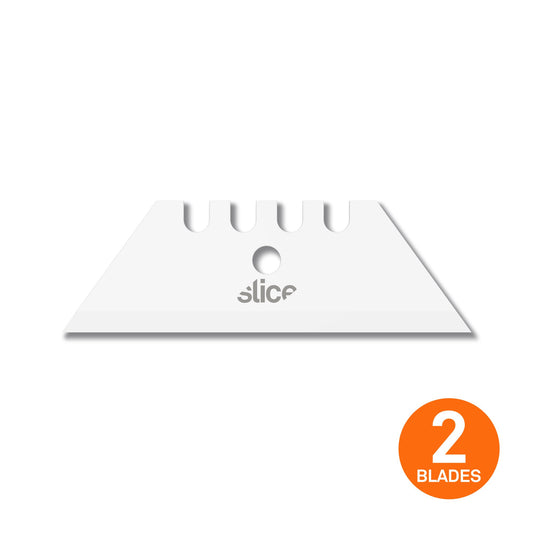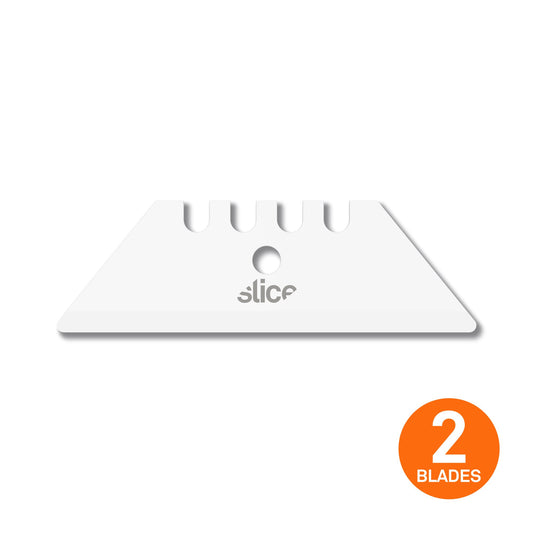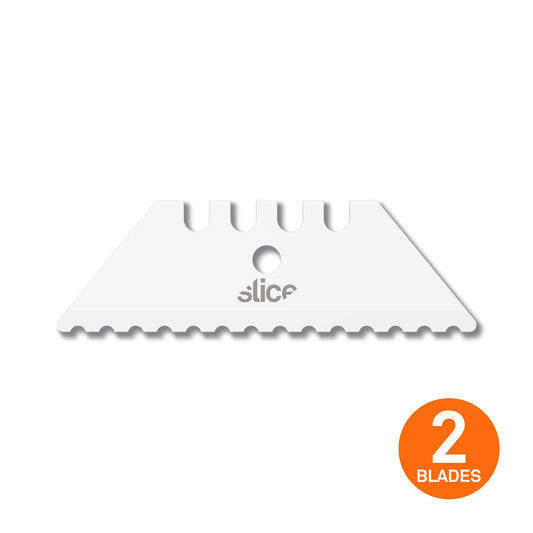-
Utility Blades (Pointed Tip)
Regular price $38.84 AUDRegular priceUnit price per -
Utility Blades (Rounded Tip)
Regular price $41.30 AUDRegular priceUnit price per -
Utility Blades (Serrated)
Regular price $38.84 AUDRegular priceUnit price per
Translation missing: en.accessibility.faq_content_title
What Are Utility Blades?
Utility blades have been around since the first time someone realized they could use a rock edge to cut their meat and set about breaking rocks to fashion cutting tools. The key to understanding these blades is that they’re prized for their utility: their ability to reliably cut a wide variety of materials. These blades are generalists, not specialists.
How Are Slice Utility Replacement Blades Safer?
Slice looked at the traditional utility blade design and asked: How can the design be improved from a safety standpoint without sacrificing effectiveness?
Our first innovation was to use a blade made from 100 percent zirconium oxide, an advanced ceramic material that’s much harder than steel. Slice recognized that advanced ceramics have superior wear resistance: they can therefore be sharpened to a level that’s effective without being extremely dangerous, and they’ll stay that way up to 11 times longer than steel.
Slice safety blades also features these properties:
It’s also important to understand the relationship between sharpness and safety. The focus for blade design has historically been on sharpness: the sharper the better, goes the conventional thinking. This is another assumption that Slice examined and found wanting.
It turns out that the sharpness we’re used to in steel blades far exceeds what’s necessary to cut materials. The only reason manufacturers sharpen metal blades to this degree is that metal dulls relatively quickly. Because extreme sharpness is what most consumers have come to expect, other ceramic blade manufacturers have copied the overly sharp design that characterizes metal blades. And so, even if a ceramic blade is made from 100 percent zirconium oxide, without Slice’s proprietary edge, it’s no safer when it contacts skin.
We developed a patent-pending grind that disperses cutting force in such a way as to displace skin and shorten the initial cutting zone. The result is our finger-friendly® blade edge that cuts your materials but is safe enough to touch.
Safety improvements to knives have, until very recently, been modifications of their handles to reduce blade exposure. Slice is the first company to redesign the blade edge itself in order to reduce accidental lacerations.
Our first innovation was to use a blade made from 100 percent zirconium oxide, an advanced ceramic material that’s much harder than steel. Slice recognized that advanced ceramics have superior wear resistance: they can therefore be sharpened to a level that’s effective without being extremely dangerous, and they’ll stay that way up to 11 times longer than steel.
Slice safety blades also features these properties:
- Non-conductive
- Non-magnetic
- Non-sparking
- Chemically inert
- Never rusts
It’s also important to understand the relationship between sharpness and safety. The focus for blade design has historically been on sharpness: the sharper the better, goes the conventional thinking. This is another assumption that Slice examined and found wanting.
It turns out that the sharpness we’re used to in steel blades far exceeds what’s necessary to cut materials. The only reason manufacturers sharpen metal blades to this degree is that metal dulls relatively quickly. Because extreme sharpness is what most consumers have come to expect, other ceramic blade manufacturers have copied the overly sharp design that characterizes metal blades. And so, even if a ceramic blade is made from 100 percent zirconium oxide, without Slice’s proprietary edge, it’s no safer when it contacts skin.
We developed a patent-pending grind that disperses cutting force in such a way as to displace skin and shorten the initial cutting zone. The result is our finger-friendly® blade edge that cuts your materials but is safe enough to touch.
Safety improvements to knives have, until very recently, been modifications of their handles to reduce blade exposure. Slice is the first company to redesign the blade edge itself in order to reduce accidental lacerations.
Does a Slice Utility Blade Need Maintenance?
If you’re considering switching to Slice, know that you’ll spend less time looking up, “How to dispose of utility blades” and “How to sharpen utility blades”. Our advanced ceramics are hand sharpened on a diamond grinding wheel to very specific angles in order to create our finger-friendly edge. We don’t recommend sharpening our blades yourself, as this will ruin the proprietary edge. That said, our blades last up to 11 times longer than standard steel blades, so you won’t need to replace them nearly as often. Where possible, our knives are designed so that once you’ve worn down the edge, you can flip over the blade in its housing to start with a fresh edge (that’s up to 11 times longer, times two!).
If you’re using our rounded-tip blades, when you’ve finally worn them out, they can be disposed of without a special utility blade holder or sharps box, due to their safer edges and rounded tips. And zirconium oxide is 100 percent recyclable, so look for a ceramics recycling facility or send your used blades to our headquarters in San Jose for recycling.
If you’re using our rounded-tip blades, when you’ve finally worn them out, they can be disposed of without a special utility blade holder or sharps box, due to their safer edges and rounded tips. And zirconium oxide is 100 percent recyclable, so look for a ceramics recycling facility or send your used blades to our headquarters in San Jose for recycling.
What Kinds of Utility Replacement Blades Does Slice Make?
Slice makes the 10523, 10524, and 10525 blades, which are all a familiar trapezoidal shape. All three blades have the same measurements (59.5 x 19 x 0.8 mm), but offer different edge and tip options. These blades are compatible with our MIni Scrapers, our Metal-Handle Utility Knives, and more.
As with all Slice blades, our utility blades feature our patent-pending finger-friendly edge. In general, we recommend starting with rounded-tip blades, as they reduce the danger of puncture wounds and work fine for most cutting jobs. For some applications, however, pointed tips or a serrated edge may be more appropriate.
We also carry utility knife blades with two options: rounded tip (10526) and pointed tip (10528). These blades fit a different set of handles. They are compatible with the 10550, 10554, 10558, 10562, 10585, 10591, and 10593, with more handles coming.
As with all Slice blades, our utility blades feature our patent-pending finger-friendly edge. In general, we recommend starting with rounded-tip blades, as they reduce the danger of puncture wounds and work fine for most cutting jobs. For some applications, however, pointed tips or a serrated edge may be more appropriate.
We also carry utility knife blades with two options: rounded tip (10526) and pointed tip (10528). These blades fit a different set of handles. They are compatible with the 10550, 10554, 10558, 10562, 10585, 10591, and 10593, with more handles coming.
What Are the Best Utility Blades for My Application?
The best utility blade for you will be determined by your applications, but also your preferences. Generally, it’s best to start by looking at different handles: Will they fit in the space where you’ll be using them? Do they feel comfortable in your hand? From there, look at your materials. Most materials are easily cut with a rounded-tip blade, but some require a pointed-tip blade to initiate the cut. Do you need to make a sawing motion to get through your material? In that case, the serrated edge is your best choice.
What Handles Are Compatible?
Slice’s utility replacement blades fit the following handles:
- Metal-Handle Utility Knives: 10490, 10491, 10492
- EDC Pocket Knife: 10496
- Mini Scraper: 10594
Do Slice Blades Break Easily?
Many people worry that ceramic blades will break, especially if the only ceramic cutters they’ve used were designed as kitchen tools. It’s important to remember that Slice uses 100 percent zirconium oxide; not all ceramic blade manufacturers use the same material composition.
We also apply our proprietary design, so our blades are safer as well as thicker. While some microscopic chips can occur with Slice blades, these do not affect performance. No knife is designed to be subjected to a side load, so we recommend only using our tools for their intended use.
Slice tools are used in facilities around the world and favored by over half the Fortune 1000 companies. Our experience tells us that, when used properly, our utility blades will last longer than standard blades, while keeping you safer.
We also apply our proprietary design, so our blades are safer as well as thicker. While some microscopic chips can occur with Slice blades, these do not affect performance. No knife is designed to be subjected to a side load, so we recommend only using our tools for their intended use.
Slice tools are used in facilities around the world and favored by over half the Fortune 1000 companies. Our experience tells us that, when used properly, our utility blades will last longer than standard blades, while keeping you safer.



